Preservation methods have evolved throughout history, with techniques ranging from canning and pickling to freezing and dehydrating. One traditional way that has stood the test of time is preserving foods in lard.
Lard, which is rendered pig fat, has been used for centuries to extend the shelf life of various foods. Not only does it protect against spoilage, but it also imparts a rich and savory flavor to the items it preserves.
In this article, we will explore 10 foods that can be preserved in lard, showcasing our ancestors’ culinary creativity and resourcefulness.
While there are numerous, complicated scientific reasons why lard is an excellent preservation method, to keep it simple, lard creates an environment that is inhospitable to bacteria.
Lard works like salt, blocking bacteria growth and keeping food moist and flavorful. Since lard has no salt and is simply animal fat, this method is healthier and guaranteed to create a tasty meal.
Pork
 Let’s start with the obvious choice: pork preserved in lard.
Let’s start with the obvious choice: pork preserved in lard.
This method, known as confit, involves slowly cooking pork in its own fat until it becomes tender and succulent.
The result is a delectable treat that can be stored for a very long time.
Pork confit can be used in various dishes, from tacos to pasta. The key to storage of any meat when using lard is to ensure the meat is fully submerged in the fat. This prevents air from penetrating the meat and prevents the growth of dangerous bacteria.
You can learn here the simplest method for butchering and preserving a pig for a whole year without refrigeration, just as my grandparents used to do.
Herbs
This one may be obvious, but you can also preserve your fresh herbs in lard. Preserving fresh herbs in lard is a fantastic way to capture their flavors and aromas for later use.
Herb-infused lard can be used as a cooking fat, drizzled over roasted vegetables, or spread on bread for a fragrant treat. It can even be used as a unique salad dressing.
Once again, creating this delightful treat is super simple. Ensure you completely submerge the herbs in hot lard before storing them in a cool space for later. When ready to use the stored herbs, submerge the container in hot water to melt the lard and enjoy the tasty treat inside.
Chicken
You can also store chicken using lard. Chicken preserved in lard is a fantastic way to keep this versatile protein on hand for the future. I have tried this and found it helpful to combat the ever-increasing prices at the grocery store.
Related: These Are the Best Chicken Breeds for Preppers
I opted to shred the chicken and use it in sandwiches, salads, or tacos. I always ensured it was fully cooked before storing it in my cold cellar. Again. The lard ensures the meat stays moist, flavorful, and free from bacteria.
Garlic
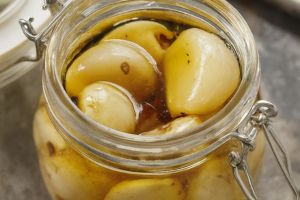 It is not only meats that can benefit from the use of lard. In fact, lard can be used with many foods to extend shelf life and infuse flavor.
It is not only meats that can benefit from the use of lard. In fact, lard can be used with many foods to extend shelf life and infuse flavor.
One excellent example is garlic. Preserving garlic in fat extends its shelf life and transforms it into a truly delicious ingredient for cooking.
The cloves, which will soften over time, can add a mellow, roasted garlic flavor to sauces, soups, and roasted vegetables.
Garlic that has been stored in fat holds in moisture and absorbs any flavors you have added to it. It is the most delightful thing to cook with if you love garlic, like I do.
Onions
Caramelized onions are a beloved addition to any dish, and you can achieve this caramelization by preserving onions in lard.
Related: How to Make Long-Lasting Tallow for Survival
Much like garlic, onions preserved in lard will hold flavor and remain moist. Use lard-infused onions to enhance the flavors of your stews, burgers, or sandwiches.
Sardines
While sardines are an acquired taste, they hold some benefits. Preserving sardines in lard is a timeless method that enhances the flavor of the fish while keeping it tender. Furthermore, preserved sardines can be enjoyed on toast, in salads, or as a protein-packed addition to pasta dishes.
Mushrooms
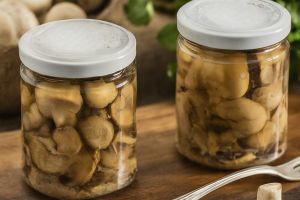 Another fantastic ingredient I always want to have on hand is mushrooms. Unfortunately, I find they spoil rather quickly. However, mushrooms preserved in lard last much longer and can be stored for extended periods.
Another fantastic ingredient I always want to have on hand is mushrooms. Unfortunately, I find they spoil rather quickly. However, mushrooms preserved in lard last much longer and can be stored for extended periods.
These mushrooms make for a savory treat or flavorful ingredient later.
⇒ The $200 a Pound Common Mushroom That Could Be Growing in Your Area
Preserved mushrooms can be added to omelets, pasta dishes, or pizza, among other things.
Cheese
Yes, you can even use lard to preserve cheese! This technique, known as cheese larding, involves encasing cheese wheels in fat to protect them from drying out or developing mold. When cheese is preserved this way, the lard provides a seal that keeps it fresh for extended periods.
Fruits
Surprisingly, fruits can also be preserved in lard. Fruits have always been a popular preservative among canners, and lard can help make this process even easier.
This technique, known as fruit confit, involves poaching fruits in a mixture of lard and sugar until they become tender and sweet. Preserved fruits can be used as a topping for desserts, stored for later use, or enjoyed as a sweet treat.
Duck
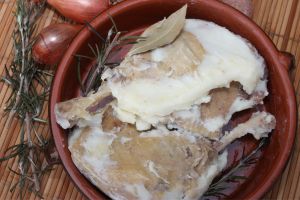 Duck confit is another classic.
Duck confit is another classic.
To make duck confit, tender duck legs are cooked in lard until they are meltingly tender and infused with flavor.
The cooked meat is then placed in a crock or large container and covered with hot lard.
Once the lard cools and hardens, the meat is encased in a protective layer. Thanks to the seal the fat provides, duck confit can be kept for 3-4 months if stored in a cool, dark space in an airtight container. When you’re ready, simply heat the meat in the oven and enjoy a gourmet meal at your fingertips.
The How To
Begin by cleaning and sterilizing the container you will use for storage. Heat your lard and cook your meat thoroughly. You can season the meat however you like, just as you would to eat it. In fact, this is an excellent option for those meals with many leftovers.
Related: 7 Deadly Canning Mistakes Even Smart People Make
Once the meat is fully cooked, create layers of meat and lard in your crock or container. Layering ensures the fat can cover every inch and no air can get in. Remember, the lard is going to be hot, so be careful. It is also important to ensure the lard covers the meat entirely and there are no areas where air pockets could form.
Ensure a generous amount of lard is on the top of the container. I usually have at least 2-3 inches of lard at the top of my storage container to ensure the meat is fully encased and protected. This is also helpful for large portions where you will be removing a small amount here and there. The excess lard remains to allow you to recover the food later if desired.
Allow the lard to solidify, and then cover it with wax paper. The wax paper will help to create a seal and keep air out of the meal without sticking to the food, breaking down, or compromising the flavor.
Cover the crock or container and store it in a dark, consistently cold place, no matter the outside temperature. That’s it. It is effortless.
Preserving foods in lard is a time-honored technique that extends the shelf life of various ingredients and enhances their flavor and versatility. The possibilities for using lard as a preservation method are endless, from meats to vegetables, herbs, and even cheese and fruits.
Whether you’re looking to experiment with classic recipes, store food for an emergency, or add a touch of culinary nostalgia to your dishes, consider giving lard preservation a try – you might discover a newfound appreciation for this traditional method.
You may also like:
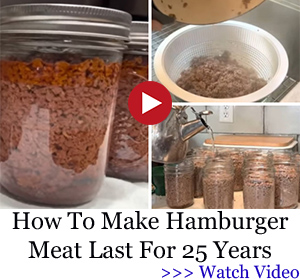 Blue Barrel Uses You Never Thought Of
Blue Barrel Uses You Never Thought Of
Cheap and Easy Way to Build a Root Cellar in Your Backyard (Video)
Read This Before Buying Survival Medicine
How To Build Your Nuclear War Survival Kit
A Medicinal Garden Kit for Starting a Small Backyard Pharmacy

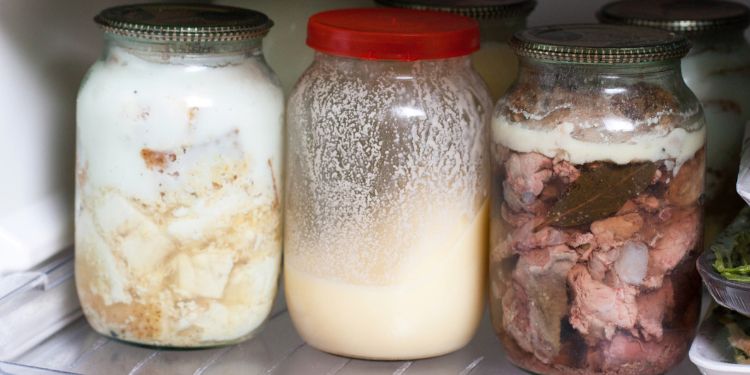




















Lard is not a staple in our food stock for preserving foods.
Pressure cooking and water bath methods were more of what my mom would do back in the day. It sounds interesting to try.
Off topic: Did you know that our AM radio stations are in jeopardy of going out of business?
The FCC is controlled by Marxist inclined leadership. On new vehicles is to eliminate AM radio in vehicles.
The new twist is George Soros and son have bought up many Spanish radio stations. But the next step is purchasing the Radio Giant Audacy Set To Exit Bankruptcy With Soros Fund Management As Largest Shareholder.
The biggest Radio network is iHEART RADIO, that is not owned by the worst financial and nation busting figurehead of the elitist world wide.
The internet is being consumed by AI. Which is programed according to the political mindsets of the people maintaining what they think they are controlling AI.
Interesting take on what is happening to our precious information being corrupted by those who do not want you to know the truth, only their truth.
Must say never thought lard was a type of antibacterial preservative to use.
I found the article about Soros buying Audacy. https://deadline.com/2024/02/audacy-bankruptcy-soros-fund-management-biggest-shareholder-1235827511/
Why aren’t people wondering why Soros should not be in prison for what he has done to us and the world?
Just recently an AM radio tower and broadcasting equipment was stolen from our local station. There has been no discovery of the persons involved or how/when they were able to take down a 250′ tower and remove it without being seen. Curious.
The reason they want to get rid of AM radio is because there are a *lot* of conservative talk shows on there that go against their elitist deviate plans. You know free speech and all. . .Get rid of AM, you get rid of conservative talk radio!
MOST AM talk is now simulcast on FM, either in the primary or a secondary HD digital channel. In 2021 there was an FCC effort to “revitalize” AM radio, but it is still met with technical issues. There is much more to the situation AM radio is in from a technical, physics, financial, and technology standpoint. I predict AM radio will go away eventually, if for anything the amount of effort that has to go into curbing interference at night and the competing influences of streaming media. From a pure radio standpoint, I believe it will be replaced by FM digital which can have many “stations” on a single frequency. Although FM will still not be wide coverage like AM can be, it will be the local broadcast source for news, traffic, weather, and other events, plus a range of music and talk choices. Much like TV has done in the last 20 years, with changing frequency ranges, broadcast capabilities and technologies, the analog “amplitude modulation (AM)” radio will be transformed to all digital.
iHeart is *now* owned, not *not* owned. . .
What a weenie, it’s the message intended.
This article has some good points as far as doing homemade food preservation for the family.
Even if the lard or pork fat is used, could you trust your next door neighbor who made that food, followed the process properly?
I have seen cooks at different restaurants that wear gloves but still touch their face, nose and continue to cook without using an alcohol wipe or dish soap. Before continuing to prepare the food.
Most of the time the food gets cooked at the proper temperature.
I remember taking a food server class before you can work in a restaurant, but that was years ago.
Great article to add to our prepping skills when the time comes. I do keep some bacon fat in a jar in the fridge when you want a little more flavor to the meal.
The deception with the gloves is, “Who are they protecting?” Not us, their customers! Just watch any drive-thru and you will see the person wearing the same gloves use the cash register, handle the money, put your food in the bag and then empty the trash. . .without changing the gloves!
Great article. Gonna go to store and price lard. I like the idea of using this as a storage method for leftovers – instead of freezer. Tacos anyone?
It’s better if you can render your own. Ask the butcher for leaf lard (great for pie crust) or fatback.
I wish the article would have mentioned how long each item can be stored like this. Only the duck confit gets a timeline.
Yes how long does this lard, fat protect the foods preserved?
1, 5, 10, 25 years like the My Patriot Food packages would do for 25 years, has anyone tried it and figured out what the maximum safe period is? Thank you.
As to the lard. The Eskimos have used whale blubber (lard) or seal oil (fat) to preserve their meat, fruit and seafood since the beginning of time. They dry their meat and drop it in.
They have a very long winter season to help.
Interesting article, never done it but this could expand our capabilities. That is what this site is all about. Can anyone expand on how cool it should be kept or risks of food poisoning? I want to try it but I guess I would feel better if someone was here to show me firsthand so I don’t screw it up.
May I ask approximately how long you, “extend” the life of the meats? This would be helpful to know
Thank you in advance
I believe that you can purchase canned lard at Walmart. You will have to check for “Country of Origin.” This I do not know. I can recall that my grandmother always kept lard on her stove for frying. It was mentioned earlier but I will second that pie crust, especially for flakiness is greatly improved by replacing the Crisco with lard. Anyone who still makes their own pie crusts for a meat pie or a beef stew pie should give it a try. Of course, when using beef stew, you are basically just incorporating the beef, potatoes, carrots, etc. and not the liquid, unless you thicken it with flour (some grate a potato, but I have had little success). If you are in a rush a large can of Dinty Moore doesn’t make a bad pie when you are hungry.
I second or third the pie crust made is definitely flaky, yum.
The Country of Origin is important such as Made in China and other adversarial countries we are in conflict with in the Bidenomics era.
China owns a large percentage of our American based meat processing plants that can adulterate our food sources. You wonder about our open border letting in Chinese military age males and females into our country.
They don’t need to kill us with lead bullets there are others ways they have in mind.
Our American food supply is a national security problem as we let the illegals into our country working in the food industry.
Has anyone ever used honey as a storage medium? I was considering keeping beef jerky, pork and chicken like this.
I’m not so certain that simply putting cooked food into lard is going to “preserve” it. I believe it must be either canned or refrigerated/frozen to make it safe. Garlic in oil (lard…) is NOT safe to eat unless it is refrigerated. That makes me believe that this process ONLY will NOT make foods safe to eat if you don’t otherwise keep it cold, frozen or canned.
Lots of things are called “Preserved”, that really aren’t:
Fermenting is called being preserved, however almost ALL fermented foods require refrigeration or freezing to make it safe to consume “long term”… canning fermented foods will kill the beneficial enzymes that fermenting provides.
So, be VERY careful about this method. I would definitely check up on these facts before doing this method only.
Lard in itself is ok if not refrigerated for long times as long as it isn’t in a hot area.
Anyone know if beef tallow will work as ‘lard’? I don’t do pork.. but the method is interesting. Thanks all!